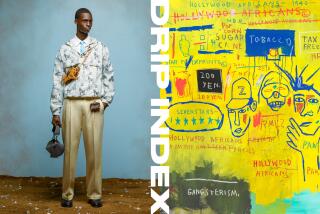Billy Al Bengston re-creates Ferus Gallery at Samuel Freeman
Billy Al Bengston knows that when it comes to art, presentation is crucial. So the 75-year-old artist and his agent, Samuel Freeman, decided to mark a milestone in Bengston’s career in an unusual way.
This year is the 50th anniversary of Bengston’s second solo show at the famed Ferus Gallery, the outsider gallery that nurtured the raucous and eccentric crowd of talented young Southern California artists in the ‘50s and ‘60s, including John Altoon, Ed Moses, Larry Bell, Ken Price, Ed Ruscha and Bengston.
Bengston and Freeman have mounted the artist’s new show, which opened Tuesday, as a re-creation within a re-creation: Paintings from his 1960 exhibition are shown within a scale replica of the Ferus Gallery built for the occasion in Freeman’s gallery in Bergamot Station (plus newer work elsewhere in the space).
FOR THE RECORD:
An earlier version of this article said the exhibition opens Wednesday. The show opened Tuesday.
It’s a neat trick that resembles the work of the artist. Most of Bengston’s well-known paintings contain a central image inside of a box within another box. In the case of this particular show, called “Billy,” that central image is a heart, and the paintings themselves are called “Valentines.”
“Billy wanted to take one of the largest spaces at Bergamot and cut it in half,” said Freeman, 34, of his main gallery, which is 40-by-27-feet wide, has a soaring corrugated tin ceiling and an unpolished concrete floor.
“He wanted to take this enormous ceiling and drop it down to 12 feet. He wanted carpet and acoustical tile; and it’s wrong, so wrong,” he said wryly.
Over the last three weeks, Bengston has directed Freeman to build a diminutive 15-by-27-foot-wide room; rewire the gallery’s electricity to accommodate a single track light equipped with bright halogen bulbs; drop the ceiling to 12 feet and fit it with acoustical tile; apply coats of paint with a pale veneer; and acquire Frank Gehry-designed furniture.
“The effect is compact, hot and bright,” said Freeman. “Like Ferus, it is a very compressed and charged environment.”
Bengston has long been known as a provocateur. He was considered outlandish even at Ferus.
Before he began spray-painting on dented aluminum in 1965 (revolutionary at that time), he had begun to use a chevron -- placed at the center of his paintings -- as a kind of signature. It angered many people at a time when the country was sharply divided over the war in Vietnam.
“It was the hors d’oeuvre of the day,” Bengston said, waving his hand somewhat dismissively. “I was really just trying to do something different. I was consciously trying to seriously paint a pretty picture, and to this day that is my primary interest in life.”
Bengston and his wife, Wendy Al, came to the gallery on a rainy afternoon for a meeting with Freeman. Wearing a brightly colored argyle sweater, a maroon neckerchief and a brown beret, the white-haired artist’s blue eyes flashed good-humored mischief. “It just so happens that my idea of a pretty picture is entirely different than most people’s idea of a pretty picture.”
For an acutely masculine man who once raced motorcycles, liberally salts his language with profanity and talks joyfully and often about his recent obsession with Internet pornography, Bengston’s work is remarkably pretty.
Counterintuitive colors play off one another luminously, perfect circles hover inside of rigid squares and bifurcated hearts bring a sense of warmth and vivid humanity to his canvases; one that was complemented by the humble environs of the old Ferus Gallery is now being complemented by its re-creation.
“Billy knows that to present a beautiful painting on a white wall with a monochrome floor is to suck all the life out of it,” said Freeman.
And although Bengston cheerfully asserts that he painted “the most modern picture ever painted” in the early 1960s because “It was only a painting; there was no reference to anything,” he is not a man living in the past, and re-creating Ferus was not a sentimental act. He just wanted to do something different.
“Billy is and always has been the elephant in the room,” said Freeman, adding that the unusual blend of cultural and artistic anarchy that coalesced to create the original Ferus Gallery (which lasted from 1957 to 1966) is gone for good.
“It was a fleeting moment, and it was poignant because of it,” Freeman said. “That was the moment that art was morphing from craft into fine art with no other purpose. Then it became a business, and it was the money that drove Billy out of Ferus, and it was the money that ultimately drove Ferus under.”
In that spirit, there will be no price list at the show. “Billy’s prices are creative,” said Freeman, managing to wince and laugh at the same time. “If a person finds a piece that they love, they have to court that painting, they have to woo it.”
Bengston, however, woos no one and is known for leaving most events, including his own openings, early.
The original solo show that “Billy” is celebrating opened at 8 p.m. Monday, Feb. 15, 1960. The private reception for the reprise at Samuel Freeman was scheduled to end at exactly 8 p.m. Monday, Feb. 15, 2010.
“I’m personally going to raise a toast at that point in time and then turn out the lights and go home,” said Freeman. “Billy won’t be there. He will have left a half an hour ago.”
More to Read
The biggest entertainment stories
Get our big stories about Hollywood, film, television, music, arts, culture and more right in your inbox as soon as they publish.
You may occasionally receive promotional content from the Los Angeles Times.











